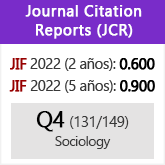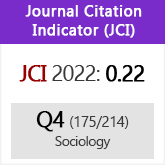El modelo de demandas-control-apoyo y su relación con el riesgo percibido de enfermedad-accidente. Una aplicación a la Comunidad Autónoma andaluza
DOI:
https://doi.org/10.3989/ris.2012.07.26Palabras clave:
Encuesta andaluza de condiciones de trabajo, Modelo de Demandas-Control-Apoyo (Modelo JDC(-S)), Modelos de ecuaciones estructurales con variables latentes, Riesgo percibidoResumen
El presente trabajo analiza de qué modo los componentes del modelo de Demandas-Control-Apoyo-JDC(-S) influyen en el riesgo percibido de enfermedad o accidente en el lugar de trabajo y, en concreto, el papel del Control y del Apoyo como variables moduladoras entre las Demandas y el Riesgo percibido. Para ello se ha analizado la estructura dimensional de las componentes de dicho modelo a partir de la Primera Encuesta Andaluza de Condiciones de Trabajo. La muestra final está formada por 7.512 trabajadores y la aproximación metodológica se concreta en los Modelos de Ecuaciones Estructurales con Variables Latentes. Los resultados indican que cabe diferenciar cuatro dimensiones en dicho modelo, de las cuales únicamente tres se muestran condicionantes del Riesgo percibido (Demanda Cuantitativa, Control y Apoyo). Paralelamente, no se obtiene evidencia que sustente la modulación del Control y del Apoyo entre las Demandas y el Riesgo percibido.
Descargas
Citas
Aiken, L. S. y S. G. West. 1991. Multiple Regression: Testing and Interpreting Interactions. Newbury Park, CA: Sage.
Akerboom, S. y S. Maes. 2006. "Beyond demand and control: The contribution of organizational risk factors in assessing the psychological well-being of health care employees". Work & Stress 20:21-36. http://dx.doi.org/10.1080/02678370600690915
Alonso, E. y C. Pozo. 2002. "La percepción del riesgo en la prevención de accidentes laborales". Apuntes de Psicología 3:1-7.
Anderson, J. C., y D. W. Gerbing. 1988. "Structural equation modeling in practice: A review and recommended two-step approach". Psychological Bulletin 103:411-423. http://dx.doi.org/10.1037/0033-2909.103.3.411
Bagozzi, R. P. 1980. Causal Models in Marketing. North Carolina: John Wiley & Sons, Inc.
Bagozzi, R. P. 2010. "Structural equation models are modelling tools with many ambiguities: Comments acknowledging the need for caution and humility in their use". Journal of Consumer Psychology 20:208-214. http://dx.doi.org/10.1016/j.jcps.2010.03.001
Bakker A. B., E. Demerouti y W. Verbeke. 2004. "Using the job demands-resources model to predict burnout and performance". Human Resource Management 43:83-104. http://dx.doi.org/10.1002/hrm.20004
Bentler, P. M. 1989-2006. EQS Structural Equations Program Manual. Encino, CA: Multivariate Software.
Bentler, P. M. y A. Satorra 2000. "Hierarchical Regression Without Phantom Factors". Structural Equation Modeling 7:287-291. http://dx.doi.org/10.1207/S15328007SEM0702_8
Blanch, J. M., M. Sahagún y G. Cervantes. 2010. "Estructura Factorial del Cuestionario de Condiciones de Trabajo". Revista de Psicología del Trabajo y de las Organizaciones 26:175-189. http://dx.doi.org/10.5093/tr2010v26n3a2
Bollen, K. A. 1989. Structural Equations with Latent Variables. Nueva York: Wiley.
Browne M. W. y R. Cudeck. 1993. "Alternative Ways of Assessing Model Fit". Pp.136-162 in Testing Structural Equation Models. Newbury Park, CA: Sage.
Browne, M. W y R. Cudeck. 1989. "Single sample cross-validation indices for covariance structures". Multivariate Behavioral Research 24:445-455. http://dx.doi.org/10.1207/s15327906mbr2404_4
Cabezas, C. 2000. La calidad de vida de los profesionales. Madrid: Materiales Formación Médica Continuada en Atención Primaria.
Castro, R., L. Campero y B. Hernández. 1997. "La investigación sobre apoyo social en salud: situación actual y nuevos desafíos". Revista de Saúde Pública 31:425-435. http://dx.doi.org/10.1590/S0034-89101997000400012
Cohen, J., y P. Cohen. 1983. Applied Multiple Regression/Correlation Analysis for the Behavioral Sciences. 2nd ed. Hillsdale, NJ: Lawrence Erlbaum Associates, Inc.
Cudeck, R. y M. W. Browne. 1983. "Cross-validation of covariance structures". Multivariate Behavioral Research 18:147-167. http://dx.doi.org/10.1207/s15327906mbr1802_2
Ministerio de la Presidencia de España. 1995. Agencia Estatal Boletín Oficial del Estado. Ley 31/1995, de 8 de noviembre, sobre Prevención de Riesgos Laborales. 269:32590-32611; 10 de noviembre de 1995. Madrid: Boletín Oficial del Estado.
Fillion, I., M. Tremblay, M. Truchon, D. Coˆte, C. W. Struthers y R. Dupuis. 2007. "Job Satisfaction and Emotional Distress Among Nurses Providing Palliative Care: Empirical Evidence for an Integrative Occupational Stress-Model". International Journal of Stress Management 14:1-25. http://dx.doi.org/10.1037/1072-5245.14.1.1
Fornell, C. y D. F. Larcker. 1981. "Evaluating Structural Equation Models with Unobservable Variables and Measurement Error". Journal of Marketing Research 18:39-50. http://dx.doi.org/10.2307/3151312
García, A. 2006. "Percepción de riesgo, piedra angular psicosocial y formativa". Formación de Seguridad Laboral 85:27-33.
Gracia, F. J., I. Silla, J. M. Peiró y L. Fortes-Ferreira. 2006. "El estado del contrato psicológico y su relación con la salud psicológica de los empleados". Psicothema 18:256-262.
Griffin, J. M., B. A. Greiner, S. A. Stansfeld y M. Marmot. 2007. "The effect of self-reported and observed job conditions on depression and anxiety symptoms: A comparison of theoretical models". Journal of Occupational Health Psychology 12:334-349. http://dx.doi.org/10.1037/1076-8998.12.4.334
Grönlund, A. 2007. "More control less conflict? Job demand-control, gender and work-family conflict". Gender, Work and Organization 14:476-497. http://dx.doi.org/10.1111/j.1468-0432.2007.00361.x
Hair, J. F., W. C. Black, B. J. Babin, R. E. Anderson y R. L. Tatham. 2006. Multivariate Data Analysis. 6th ed. Upper Saddle River, New Jersey: Prentice Hall.
Häusser, J. A., A. Mojzisch, M. Niesel y S. Schulz-Hardt. 2010. "Ten years on: A review of recent research on the Job Demand-Control (-Support) model and psychological well-being". Work & Stress 24:1-35. http://dx.doi.org/10.1080/02678371003683747
Hu, L. y P. M. Bentler. 1999. "Cutoff criteria for fit indexes in covariance structure analysis: Conventional criteria versus new alternatives". Structural Equation Modeling 6:1-55. http://dx.doi.org/10.1080/10705519909540118
Instituto Andaluz de Prevención de Riesgos Laborales. 2008. 1.ª Encuesta Andaluza de Condiciones de trabajo. Sevilla: Ed. Junta de Andalucía, Consejería de Empleo.
ISTAS. 2004. "Identificación y evaluación de riesgos psicosociales". Madrid: Instituto Sindical de Trabajo, Ambiente y Salud. Consulta 21 de marzo de 2010 (http://www.istas.net/web/index.asp?idpagina=3185).
Janssen, O. 2000. "Job demands, perceptions of effort-rewards fairness and innovative work behavior". Journal of Occupational and Organizational Psychology 73:287-302. http://dx.doi.org/10.1348/096317900167038
Johnson, J. V. y E. M. Hall. 1988. "Job Strain, Work place social support and cardiovascular disease: a cross-sectional study of a random sample of the Swedish working population". American Journal of Public Health 78:1336-1342. http://dx.doi.org/10.2105/AJPH.78.10.1336
Jöreskog, K. G. 1993. "Testing structural equation models", Pp. 294-316 en Testing Structural Equation Models. Newbury Park, CA.: Sage Publications.
Jöreskog, K. G., D. Sörbom. 1996. LISREL 8: User's Reference Guide. USA: SSI Scientific Software International.
Karasek, R. 1979. "Job demands, Job decision latitude and mental strain: Implications for job redesign". Administrative Science Quarterly 24:285-308. http://dx.doi.org/10.2307/2392498
Karasek, R. y T. Theorell. 1990. Healthy work: stress, productivity and the reconstruction of the working life. Nueva York: Ed. Basic Books.
Karasek. R. 1990. "Lower health risk with increased job control among white collar workers". Journal of Organizational Behaviour 11:171-185. http://dx.doi.org/10.1002/job.4030110302
Kleinman, A., L. Eisenberg y B. Good. 1978. "Culture, illness and care: clinical lessons from anthropologic and cross-cultural research". Annals of internal Medicine 88:251-8. http://dx.doi.org/10.7326/0003-4819-88-2-251
Kristensen, T. y V. Borg. 2001. A new tool for assessing psychosocial factors at work: the Copenhagen psychosocial questionnaire. Proceedings from the Third European Academy of Occupational Health Psychology, 24-27 octubre, Barcelona.
Landsbergis, P. A. 1988. "Occupational Stress among health care workers: a test of a job demand-scontrol model". Journal of Organizational Behavior 9:217-240. http://dx.doi.org/10.1002/job.4030090303
(De) Lange A. H., T. W. Taris, M. A. J. Kompier, I. L. D. Houtman y P. M. Bongers. 2002. "Effects of stable and changing demand–control histories on worker health". Scandinavian Journal of Work, Environment & Health 28:94-108. http://dx.doi.org/10.5271/sjweh.653
López Araujo, B., A. Osca Segovia y J. M. Peiró. 2007. "El papel modulador de la implicación con el trabajo en la relación entre el estrés y la satisfacción laboral". Psicothema 19:81-87.
MacDonald, L. A., R. Karasek, L. Punnett, y T. Scharf. 2001. "Covariation between workplace physical and psychosocial stressors: evidence and implications for occupational health research and prevention". Ergonomics 44:696-718.
Martín, J. M., L. Luce-o, M. Jaén y S. Rubio. 2007. "Relación entre factores psicosociales adversos, evaluados a través del cuestionario multidimensional Decore, y salud laboral deficiente". Psicothema 19:95-101.
Martín, P., M. Salanova y J. M. Peiró. 2007. "Job demands, job resources and individual innovation at work: Going beyond Karasek's model". Psicothema 19:621-626.
McDonald, R. P. 1985. Factor analysis and related methods. Hillsdale. New Jersey: Lawrence Erlbaum Associates, Publishers.
Meliá, J. L. y M. Becerril. 2007. "Psychosocial sources of stress and burnout in the construction sector: A structural equation model". Psicothema 19:679-686.
Mikkelsen, A., T. Øgard y P. Landsbergis. 2005. "The effects of new dimensions of psychological job demands and job control on active learning and occupational health". Work & Stress 19:153-175. http://dx.doi.org/10.1080/02678370500167808
Muthén, L. K. y B. O. Muthén. 1998-2007. Mplus User's Guide. Fifth Edition. Los Angeles, CA: Muthén and Muthén.
Nunnally, J. C. y I. H. Bernstein. 1994. Psychometric Theory. New York: McGraw-Hill.
Pelfrene, E., P. Vlerick, R. P. Mak, P. Smet, M. Kornitzer y G. Backer. 2001. "Scale reliability and validity of the Karasek' job demand-control-support' model in the Belstress study". Work & Stress 15:297-313. http://dx.doi.org/10.1080/02678370110086399
Pérez, J. y F. Martín. 1997. "El apoyo social". Nota técnica del Instituto Nacional de Seguridad e Higiene en el trabajo NTP 439.
Portell, M., M. D. Riba y R. Payés. 1997. "La definición de riesgo: implicaciones para su reducción". Revista de Psicología de la Salud 9:3-27.
Quick, J. C., J. D. Quick, D. L. Nelson y J. J. Hurrell. 1997. Preventive Stress Management in Organizations. Washington, DC: American Psychological Association. http://dx.doi.org/10.1037/10238-000
Rafferty, Y., R. Friend y P. Landsbergis. 2001. "The association between job skill discretion, decision authority and burnout". Work & Stress 15:73-85.
Sanne, B., A. Mykletun, A. A. Dahl, B. E. Moen y G. S. Tell. 2005. "Testing the Job Demand-Control-Support model with anxiety and depression as outcomes: the Hordaland Health Study". Occupational Medicine 55:463-473. http://dx.doi.org/10.1093/occmed/kqi071
Sargent, L y D. Terry. 2000. "The moderating role of social support in Karasek's job strain model". Work & Stress 14:245-261. http://dx.doi.org/10.1080/02678370010025568
Satorra, A. y P. M. Bentler. 1994. "Corrections to test statistics and standard errors in covariance structure analysis". Pp. 349-419 en Latent Variables Analysis: Applications for Developmental Research. Thousand Oaks, CA: Sage.
Satorra, A. 2003. "Power of chi-square Goodness-of-fit test in structural equation models: the case of non-normal data". Pp. 57-68 en New Developments of Psychometrics. Tokyo: Springer Verlag.
Schaufeli, W. y A. Bakker. 2004. "Job demands, job resources, and their relationship with burnout and engagement: a multi-sample study". Journal of Organizational Behavior 25:293-315. http://dx.doi.org/10.1002/job.248
Sjöberg, L. 2000. "Factors in risk perception". Risk Analysis 20:1-11. http://dx.doi.org/10.1111/0272-4332.00001
Sjöberg, L. 2002. "Are received risk perception models alive and well?" Risk Analysis 22:665-669. http://dx.doi.org/10.1111/0272-4332.00058
Tucker, J. S., R. R. Sinclair, C. D. Mohr, A. B. Adler, J. L. Thomas y A. D. Salvi. 2008. "A temporal investigation of the direct, interactive, and reverse relations between demand and control and affective strain". Work & Stress 22:81-95. http://dx.doi.org/10.1080/02678370802190383
Van der Doef, M. y S. Maes. 1999. "The Job Demand-Control (-Support) model and psychological wellbeing: a review of 20 years of empirical research". Work & Stress 13:87-114. http://dx.doi.org/10.1080/026783799296084
Van Vegchel, N., J. Jonge y P. Landsbergis. 2005. "Occupational stress in (inter)action: the interplay between job demands and job resources". Journal of Organizational Behavior 26:535-560. http://dx.doi.org/10.1002/job.327
Vermeulen, M. y C. Mustard. 2000. "Gender differences in job strain, social support at work, and psychological distress". Journal of Occupational Health Psychology 5:428-440. http://dx.doi.org/10.1037/1076-8998.5.4.428
Wall, T. D., P. R. Jackson y S. Mullarkey. 1995. "Further evidence on some new measures of job control, cognitive demands and production responsibility". Journal of Organizational Behavior 16:431-455. http://dx.doi.org/10.1002/job.4030160505
Wall, T. D., P. R. Jackson, S. Mullarkey y S. K. Parker. 1996. "The demands-control model of job strain: a more specific test". Journal of Occupational and Organizational Psychology 69:153-166. http://dx.doi.org/10.1111/j.2044-8325.1996.tb00607.x
Wong, S., G. de Santics y N. Staudemayer. 2007. "The relationship between task interdependency and role stress: a revisit of the job demands-control model". Journal of Management Studies 44:284-303. http://dx.doi.org/10.1111/j.1467-6486.2007.00689.x
Zimolong, B. y R. Trimpop. 1998. "Risk perception". Encyclopaedia of Occupational Health and Safety, vol. 2, 25-32. Geneva: ILO.
Descargas
Publicado
Cómo citar
Número
Sección
Licencia
Derechos de autor 2013 Consejo Superior de Investigaciones Científicas (CSIC)

Esta obra está bajo una licencia internacional Creative Commons Atribución 4.0.
© CSIC. Los originales publicados en las ediciones impresa y electrónica de esta Revista son propiedad del Consejo Superior de Investigaciones Científicas, siendo necesario citar la procedencia en cualquier reproducción parcial o total.Salvo indicación contraria, todos los contenidos de la edición electrónica se distribuyen bajo una licencia de uso y distribución “Creative Commons Reconocimiento 4.0 Internacional ” (CC BY 4.0). Puede consultar desde aquí la versión informativa y el texto legal de la licencia. Esta circunstancia ha de hacerse constar expresamente de esta forma cuando sea necesario.
No se autoriza el depósito en repositorios, páginas web personales o similares de cualquier otra versión distinta a la publicada por el editor.

















